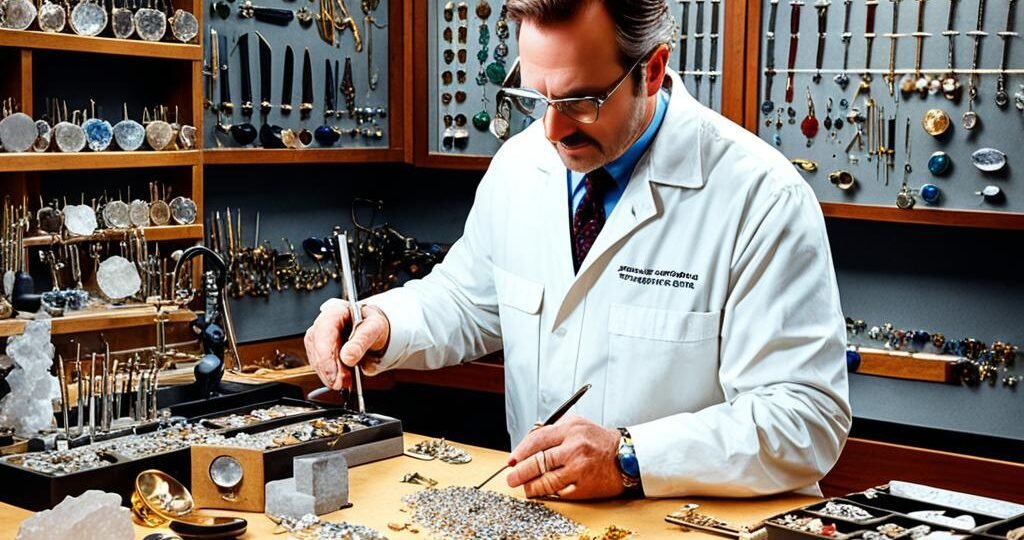
Welcome to Devil n Dove, where curiosity meets craft. We invite you to dive into the world of jewelry making and crafts, embarking on a journey of learning and growth with each project. From the very first sketch to the final piece, be a part of our adventure as we explore the fascinating art of creating unique and meaningful jewelry.
At Devil n Dove, we believe that every creation tells a story. We are passionate about infusing our designs with a touch of creativity and imagination, making each piece a true work of art. Our dedication to craftsmanship and attention to detail ensures that every jewelry item we produce is of the highest quality, reflecting the beauty and uniqueness of its wearer.
Subscribe and hit notifications to join us on this exciting journey, where inspiration awaits at every turn. As we share our insights, tips, and techniques, you’ll discover a world of possibilities that will inspire your own creativity and enhance your jewelry-making skills.
Support us at www.devilndove.com or our store at www.devilndove.online.
Key Takeaways:
- Choose jewelry materials based on factors like metal choice, budget, weight, maintenance, and allergies.
- Common metals used in jewelry include gold, silver, and platinum.
- Alternative metals like aluminum, copper, ceramic carbide, cobalt, stainless steel, titanium, and tungsten offer unique characteristics and affordability.
- Consider factors like hardness, rarity, and hypoallergenic properties when selecting jewelry materials.
- Understanding the properties of different metals can help you make informed decisions and create stunning jewelry pieces.
Platinum
Platinum jewelry is a stunning choice for those seeking elegance and sophistication. Its durability, strength, and scratch resistance make it a popular option for engagement rings, wedding bands, and other precious pieces. Its naturally white color exudes a timeless beauty that doesn’t fade or tarnish over time.
Platinum is known for its rarity, making it a prized metal among jewelry enthusiasts. It belongs to the platinum group metals, which include palladium, rhodium, ruthenium, iridium, and osmium. These metals are often combined to enhance platinum’s properties and create exquisite pieces of jewelry.
For jewelry to be considered “platinum,” it must meet a minimum purity level of at least 90% pure platinum. This high level of purity ensures that the jewelry maintains its superior quality and value.
Platinum’s unique properties allow for intricate designs and precise engravings, making it a favorite among artisans and craftsmen. However, it is essential to note that platinum is a softer metal compared to others, like gold, and may develop a patina finish over time.
The Durability and Strength of Platinum
One of the outstanding features of platinum is its remarkable durability and strength. It is stronger and more resilient than gold, ensuring that your platinum jewelry withstands the test of time. Its strength makes it a perfect choice for everyday wear, as it can withstand the rigors of daily life without losing its integrity.
Scratch Resistance and White Color
Platinum’s scratch resistance is commendable, but it is important to note that it can still develop fine scratches with regular wear. However, these scratches become a part of the metal’s natural patina over time, giving it a distinctive and vintage look.
The naturally white color of platinum sets it apart from other metals. Unlike white gold, which requires rhodium plating to achieve its white hue, platinum’s inherent white color remains consistent throughout its lifetime. It offers a brilliant and lustrous appearance that complements any gemstone setting.
Rarity and Purity
Platinum is renowned for its rarity, making it a coveted metal for jewelry enthusiasts. Its scarcity contributes to its higher price compared to gold. Platinum’s purity, with a minimum of 90% pure platinum content, ensures that each piece of jewelry is made with the highest quality metal.
Combining Platinum with Other Metals
Platinum can be alloyed with other metals from the platinum group to enhance its properties. These alloys may contain metals like palladium, which increases the metal’s durability and hardness. The combination of these metals creates a beautiful synergy that allows jewelry designers to create stunning and intricate pieces.
| Properties | Platinum | Gold |
|---|---|---|
| Durability | High | Moderate |
| Strength | Strong | Strong |
| Scratch Resistance | Good | Good |
| Color | Naturally white | Yellow, white, rose |
| Rarity | High | Moderate |
| Purity | At least 90% pure platinum | Varies |
Alternative Metals
When it comes to jewelry, we often think of traditional metals like gold, silver, and platinum. But did you know that there are alternative metals that can offer unique looks and properties? From lightweight aluminum to durable tungsten, let’s explore some of these alternative metals and their features.
Aluminum Jewelry
- Lightweight and comfortable to wear
- Resistant to corrosion
- Versatile and available in various finishes
- Affordable option for trendy and casual jewelry
Copper Jewelry
- Pure element that develops a natural patina over time
- Easy to manipulate and form into intricate designs
- Warm, reddish-brown color adds a unique touch
- Often used in bohemian and rustic-inspired jewelry
Ceramic Carbide Jewelry
- Durable and heat-resistant
- Hypoallergenic, making it suitable for sensitive skin
- Available in a range of colors and finishes
- Modern and stylish option for contemporary jewelry designs
Cobalt Jewelry
- Highly durable and scratch-resistant
- Resembles the appearance of white gold
- Retains its shine without the need for frequent polishing
- Popular choice for men’s wedding bands
Palladium Jewelry
- Offers similar benefits to platinum at a more affordable price
- Lightweight and hypoallergenic
- Resistant to tarnish and corrosion
- Perfect for those seeking a platinum-like look on a budget
Precious Metal Clay Jewelry
- Allows for intricate and detailed designs
- Available in silver, platinum, and gold options
- When fired, transforms into solid metal
- Ideal for creating unique and artistic jewelry pieces
Stainless Steel Jewelry
- Durable and resistant to scratches and tarnish
- Easy to clean and low maintenance
- Available in various finishes, including matte and polished
- Affordable and versatile option for everyday jewelry
Titanium Jewelry
- Lightweight and comfortable to wear
- Hypoallergenic, making it ideal for those with sensitive skin
- Strong and durable, resistant to scratches and corrosion
- Modern and sleek option for both men’s and women’s jewelry
Tungsten Jewelry
- Extremely hard and scratch-resistant
- Retains its shine without the need for frequent polishing
- Durable and long-lasting
- Popular choice for men’s wedding bands
These alternative metals offer a wide range of options for jewelry enthusiasts. Whether you’re looking for a lightweight and affordable option or a durable and hypoallergenic choice, there’s a metal that suits your style and preferences. Support us at www.devilndove.com or our store at www.devilndove.online and explore the world of unique and stylish jewelry.
Comparison of Metals
When it comes to choosing the right metal for your jewelry, it’s important to consider various factors such as durability, appearance, and personal preferences. In this section, we will compare different metals commonly used in jewelry making, highlighting their unique properties and characteristics.
Mohs Scale of Hardness
The Mohs scale of hardness is a rating system used to measure the scratch resistance of different metals. Metals with a higher rating on the Mohs scale are more resistant to scratching. This scale can be helpful in determining the durability of a metal for everyday wear jewelry.
Metal Alloys
Metal alloys play a significant role in determining the properties of the material. Alloys are composed of at least one metal combined with other elements. The addition of these elements can enhance the strength, color, and other characteristics of the metal.
Brass and Bronze
Brass and bronze are alloys of copper. Brass is a combination of copper and zinc, while bronze is created by adding tin or other elements to copper. Bronze is often used for tools, coins, and statues due to its strength and durability.
Silver
Silver is a popular choice for jewelry due to its affordability and lustrous appearance. It is a versatile metal that can be crafted into intricate designs. However, pure silver is too soft for most jewelry applications, so it is often alloyed with other metals to increase its durability.
Copper
Copper is a pure element that is commonly used in alloys for jewelry making. It is known for its warm, reddish-brown color and its ability to create beautiful patinas over time. Copper alloys can vary in composition, offering different properties and colors.
| Metal | Hardness | Color | Properties |
|---|---|---|---|
| Brass | Depends on alloy composition | Yellow, gold-like appearance | Durable and corrosion-resistant |
| Bronze | Depends on alloy composition | Reddish-brown | Strong and suitable for tools and decorative items |
| Silver | 2.5 – 3 on the Mohs scale | Bright, lustrous | Malleable, ductile, and a good conductor of heat and electricity |
| Copper | 2.5 – 3 on the Mohs scale | Reddish-brown | Highly conductive, forms patinas |
As you can see from the table, the composition of the metal alloy determines its hardness, color, and other properties. When choosing jewelry, consider your preferences, budget, and desired aesthetic to find the perfect metal that suits your style.
Next, we will explore the various properties and considerations when selecting gold jewelry.
Gold
Gold is a popular choice for jewelry, offering a classic and timeless appeal. It comes in different colors, including yellow gold, white gold, and rose gold, providing options to suit various preferences and styles.
When it comes to gold jewelry, the purity of the gold plays a significant role. Gold alloys are created by combining pure gold with other metals such as copper and zinc. The karat of gold indicates its purity level, with 24Kt gold being pure gold and other alloys being less than 24Kt.
In addition to color and purity, there are different types of gold jewelry:
- Gold-filled: These items are made by bonding a thick sheet of gold to a base metal, creating a durable and affordable option.
- Vermeil: Referring to gold plating over sterling silver, vermeil offers the luxurious look of gold at a more accessible price point.
- Gold plating: In this process, a thin layer of gold is applied to the surface of another metal, creating a gold-like appearance. However, gold plating may wear off over time.
It’s important to note that some individuals may have allergies to certain gold alloys, particularly with white gold which may contain nickel or other white metals. If you have known allergies or sensitivity, consider opting for alternative metals.
When choosing gold for your jewelry, consider factors such as color, durability, and cost. Yellow gold is a classic choice that exudes warmth, while white gold offers a contemporary and versatile look. Rose gold, with its pinkish hue, has gained popularity for its feminine and romantic appeal.
Comparison of Gold Colors and Karats
| Gold Color | Karat | Composition | Characteristics |
|---|---|---|---|
| Yellow Gold | 24Kt | Pure gold | Rich, warm color; soft and malleable |
| White Gold | Less than 24Kt (often 14Kt or 18Kt) | Gold alloyed with white metals like nickel or palladium | Contemporary, bright appearance; may cause allergies in some individuals |
| Rose Gold | Less than 24Kt (often 14Kt or 18Kt) | Gold alloyed with copper and a small amount of silver | Unique, romantic, and feminine color; durable |
Gunmetal, Nickel and Nickel Silver, Niobium
In the world of jewelry, there are many choices when it comes to selecting the right materials. In this section, we will explore gunmetal, nickel, nickel silver, and niobium. These metals offer unique properties and considerations that are worth exploring before making your jewelry decisions.
Gunmetal Finish
Gunmetal is a metal finish that carries a neutral grey background with bluish or purplish tinges. It is commonly used in gothic and steampunk designs, adding a touch of drama and sophistication. The gunmetal finish gives jewelry a distinct and edgy look, perfect for those seeking bold artistic choices.
Nickel and Nickel Silver
While nickel and nickel silver can be visually appealing and affordable choices for jewelry, it’s important to consider potential allergies. Some individuals may have sensitivities or allergies to these metals. Before making any purchase, it’s best to understand your own sensitivities and consult a professional for insight. Nickel silver, in particular, is an alloy that contains nickel, copper, and zinc, and can resemble the appearance of silver.
“The quality of nickel and nickel silver jewelry is undeniable, but it’s important to prioritize our customers’ comfort and well-being. We offer a range of carefully selected hypoallergenic options to ensure everyone can enjoy our jewelry collections.” – Devil & Dove
Niobium
Niobium is a strong and flexible metal that can be anodized to create various colors, making it a popular choice for artistic jewelry designs. It is naturally hypoallergenic, which means it is less likely to cause metal allergies. This makes niobium an excellent option for individuals with sensitivities or allergies to other metals. It is commonly used in wire and findings, contributing to its versatility and popularity among jewelry designers.
Artistic Choices and Financial Considerations
When considering gunmetal, nickel, nickel silver, or niobium for your jewelry, it’s essential to think about both artistic choices and financial considerations. Gunmetal provides a distinctive look that can elevate your style and make a statement. Nickel and nickel silver offer an affordable option for those seeking the appearance of silver, but potential allergies must be considered. Niobium, with its hypoallergenic properties and flexibility, offers a wide range of artistic possibilities.
At Devil & Dove, we understand the importance of catering to both artistic choices and financial considerations. Our expert team is dedicated to providing high-quality materials that suit your style and comfort. Visit us at www.devilndove.com or check out our store at www.devilndove.online to explore our exceptional collections.
Conclusion
When it comes to choosing the right jewelry materials, there are several important factors to consider. Durability, color, maintenance, allergies, and cost all play a role in determining the best option for your needs. While gold, silver, and platinum are popular choices, there is a wide range of alternative metals to explore.
Metals like aluminum, copper, ceramic carbide, cobalt, palladium, precious metal clay, stainless steel, titanium, and tungsten offer unique properties and characteristics that can enhance your jewelry pieces. Understanding factors like scratch resistance, hardness, rarity, and the ability to create engravings can help you make an informed decision.
Whether you’re looking for a classic, timeless piece or something more affordable and unique, there are jewelry materials available to suit your style and preferences. Consider the qualities and features that matter most to you, and don’t be afraid to explore alternative options. Trusting your own taste and making an educated decision will ensure you find the perfect materials for your jewelry collection.
If you need further guidance or wish to support us, visit our website at www.devilndove.com or browse our online store at www.devilndove.online. We are here to assist you in finding the jewelry materials that complement your unique style and individuality.
FAQ
How do I choose the right jewelry materials?
When choosing jewelry materials, consider factors such as durability, color, maintenance, allergies, and cost.
What are the most common metals used in jewelry?
The most common metals used in jewelry are gold, silver, and platinum.
What are the alternative metals used in jewelry?
Alternative metals used in jewelry include aluminum, copper, ceramic carbide, cobalt, palladium, precious metal clay, stainless steel, titanium, and tungsten.
How can I compare the different metals used in jewelry?
The Mohs scale of hardness is used to measure the scratch resistance of different metals, and metal alloys play a role in determining the properties of the material.
What should I know about platinum jewelry?
Platinum is a precious, naturally white metal that is durable, doesn’t fade or tarnish, and has a minimum level of purity of at least 90% pure platinum to be considered “platinum.”
What are the characteristics of gold for jewelry?
Gold comes in different colors such as yellow, white, and rose gold, and its purity is indicated by the karat. Gold-filled items and vermeil are also alternatives to consider.
What are the properties of gunmetal, nickel, nickel silver, and niobium for jewelry?
Gunmetal is a metal finish, nickel and nickel silver can cause allergies, and niobium is a strong and flexible metal that can be anodized to create various colors.
How do I make the best choice for my jewelry materials?
Consider factors like scratch resistance, hardness, rarity, and the ability to create engravings when choosing the right jewelry materials to suit your style and preferences.
Source Links
RELATED POSTS
View all



